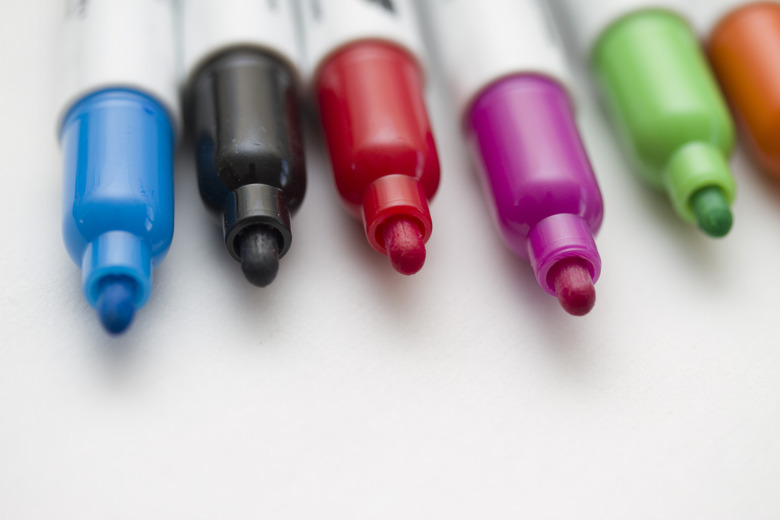How To Remove Dry-Erase Marker From A Microfiber Couch
We may receive a commission on purchases made from links.
Whether your little one tried to decorate the sofa or you accidentally marked on the upholstery, dry erase marker can make a big mess on your microfiber couch. Unlike on a dry erase board, it doesn't simply wipe away from a sofa. Tackle the marks quickly with a microfiber-friendly cleaner to restore your upholstery.
Microfiber and Dry Erase Marker
Microfiber and Dry Erase Marker
Microfiber is made from very fine, soft strands of polyester, a synthetic material. A popular choice in upholstery and furniture, it looks much like suede or leather. The microfiber upholstery is considered fairly durable, repelling water and most stains easily, but dry erase markers can still leave their mark.
The ink contains both release agents and pigments. While the release agents keep the marker from sticking to dry erase boards and other non-porous materials, when it comes in contact with carpet, clothing, or upholstery, like your microfiber couch, the color becomes trapped. However, a few household ingredients will remove the ink and leave your couch looking as good as it did before.
Things Needed
-
Cotton swab or a cotton ball
-
Soft cloths or cotton balls
-
Rubbing alcohol or clear liquor
-
Hairdryer
-
Toothbrush or soft-bristled brush
How to Remove Dry-Erase Marker From a Microfiber Couch
1. Check the Care Label
Look at the product label for care instructions. Find the care code on it: type "W" indicates water-based cleaning solutions are safe, while "S" means use only solvent-based cleaners. "S-W" shows that either solvents or water are okay, and "X" warns that your couch should only be vacuumed. If you find an "X," consult a professional for best results; using any product could potentially damage the microfiber, so proceed with caution.
2. Test the Cleaner
Find a hidden area on your microfiber couch where you can test rubbing alcohol on the material. Look for a spot under the seat cushions, on the back, or on the skirt, for instance. Rubbing alcohol is safe for most microfiber, but when improperly applied, it might leave a ring.
3. Prepare the Cotton Swab
Moisten a cotton swab or cotton ball with rubbing alcohol — preferably a 99-percent strength version because it dries faster. Use a lesser strength, alternatively, or even clear liquor, such as vodka; the alcohol is the active ingredient that will remove dry erase marker ink, so either will work. You can also spray the rubbing alcohol onto the stain.
4. Apply the Cleaner
Dab gently with the alcohol in your test location. Repeat a few times as if you were lifting ink. You want to apply enough to find out that the alcohol is not spreading too far as you dab and that the alcohol doesn't discolor the microfiber or leave a ring when it dries. Wait an hour or two after testing to look at your results. If there is no discoloration, proceed to use the alcohol to remove the marker stain.
5. Use a Soft Cloth
Switch to a soft cloth or use cotton balls, depending on the size and extent of the dry erase marker damage. Dampen with the alcohol.
6. Blot and Clean the Area
Blot the stain, using little to no pressure to make sure you aren't pushing the stain into the microfiber. Use a circular motion and gentle contact to "scrub" areas that resist removal, relying on repetition rather than force. Change to a clean cloth or cotton ball as needed. Clean small areas at a time if the marker damage is extensive.
7. Dry the Spot
Allow your microfiber to dry thoroughly. It may be difficult to see if the stain is lifted until it's dry. Use a hairdryer to dry your couch quickly, especially if you used a low-strength rubbing alcohol; this helps prevent moisture damage rings and splotches. Set the dryer on "low" and hold 8 to 10 inches away from your couch. Use caution to prevent heat damage.
8. Brush the Fabric
Use a toothbrush or other soft-bristled brush to rub the fabric, once it's dry. Rub gently without pressure. This will restore the softness and natural texture of the fabric.
Tip
If you're still unable to remove the ink stains, consider applying a dry cleaning solution with an ink remover. Other options include consulting the manufacturer for recommended products or consulting a microfiber cleaning professional who can assess your couch personally.
